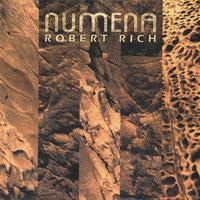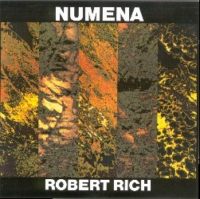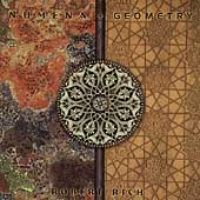|
Robert Rich was (and still is) obsessed by his love and fascination for the living world, the tensions between the symmetric and the organic.
Compared to his former albums, the music on “Numena” is less improvisational and more complex, incorporating elements of dynamic, harmonious and rhythmic structures, and a fusion with the beautiful worlds of geometrical symmetry (which would later lead to Robert’s next album “Geometry”).
Robert Rich started work on the electro-acoustic classic “Numena” in the summer of 1985, just after finishing university.
Hans Fahlberg in Sweden had recently released his “Live” cassette from two concerts in 1983, and then asked him to record an album for his new label Multimood.
The recording took about a year, in part because Robert had to move a few times next to working out some new techniques for tuning my synthesizers to just intonation (tuning based on small, whole-numbered ratios between notes), which wasn’t at all a simple question of pushing a button.
Just intonation would allow the listener to hear harmony the way it is constructed.

For the concept of “Numena”, Robert was thinking about the ancient Greco-Roman religion and its transformation to a mystical form of early Christianity in the form of the philosopher Plotinus.
In ancient Roman spirituality, a place could have an energy, which they explained in the form of gods or spirits inhabiting that place. If you came to a spot and you sensed “something” you would assume a god lived there.
This quality of sacredness – a connection between a god and a place – was called Numenon. When Robert recorded Numena, he was thinking about the ancient Greco-Roman religion, and its transformation to a mystical form of early Christianity in the form of the philosopher Plotinus.
In ancient Roman spirituality, a place could have an energy, which they explained in the form of gods or spirits inhabiting that place. If you came to a spot and you sensed “something” you would assume a god lived there. This quality of sacredness – a connection between a god and a place – was called Numenon, plural Numena.
Plotinus adapted this word Numena (sometimes spelled Noumena or Numina) to describe the hidden realities behind appearances. Plotinus treated this realm as the basis of true Reality, much as Plato treated the world of pure Form.
So for Rich, the exploration of this idea in music became most interesting when it connected the ancient with the modern. He wanted to find a sort of hole in the middle of a physical place, a portal through which he could journey into pure being.
The use of nature sounds was very important for this idea, because those sounds came from a very specific place in the high mountains where he felt a powerful energy. This grove of trees in the Sierras became the doorway.
As the album progresses, the journey goes deeper into the dreamspace, the trance world.
The last piece “The Walled Garden” (the title comes from a Sufi work by Hakim Sanai) actually comes from music that he heard in a lucid dream. Robert was dreaming that he was looking at various landscape paintings by Mati Klarwein, when he became aware he was dreaming and he felt that someone kicked him from behind and flew into one of the paintings. He found myself flying over the steep hills of the California coastline, the hills he had known since he was a child. While in this moment of clarity, he was listening to music much like what he tried to create on the last piece of the album. So, for Robert the whole album is like a journey to a place of great purity.
He often found it a challenge that nature sounds became such a cliché in mainstream New Age music (the sticky sweet stuff.)
New Age music often uses these sounds as a sort of perfume, to cover up the lack of detail in the music, much like a hotel might use a spray in the bathroom that smells like pine trees, to cover up the bathroom odor.
Robert was aware of this problem when he was working on Numena and he tried to steer the use of natural sounds away from “sound effect” and into the fabric of the music. Robert loved the way that John Cage, Bill Fontana, Annea Lockwood and others would relocate found sound and turn it into a powerful experience. Even now he still like to use natural sounds, because he loves the complexity of these environments.
Regarding instruments, Robert applied a Sequential Prophet 5, Sequential Six Trak, his homebuilt analogue modular, a lap steel guitar (gliss), flutes, gourd drums and a mallet kalimba.
Robert had a Commodore SX64 computer with the very first MIDI card from Sequential Circuits (the company actually invented MIDI).
He was running Dr. T KCS software and used it to record the arpeggios on “Other Side of Twilight.” He played these back through the Prophet 5 using one of his JI tunings (a 7-limit tuning in A that he still uses quite often), while altering timbre with the knobs, recording with echoes onto two tracks of tape. Then, everything else he played by hand in overdubs.
He had just bought a used Otari MX5050-mkIII half inch 8-track, his first multi track machine. Most of the synth sounds on “Twilight” came from the Prophet 5, with exception of the “critter noises” in the middle from the modular synth and Six-Trak.
The nature sounds at the start come from a cassette recording Rich made in the high Sierras at about 2,500 meters altitude of wind and birds at sunset while he was camping the previous year, augmented by my “bird call” responses on ocarina and fast arpeggios on Prophet 5.

Side two of “Numena” involved more exploration and discovery of new techniques with acoustic instruments. Robert wanted this side to create an invisible fusion between electronic and acoustic, where every sound was mysterious and hard to identify, especially the acoustic sounds.
So he did a lot of thick looping with the Electro Harmonix 16 second delay. Many of the sounds are half speed, and some are double speed.
Robert Rich mixed the final version of the Swedish vinyl release at a studio in San Francisco because he didn’t think he would be able to do a good job in his primitive situation.
Ironically, he came to feel that his rough mixes sounded better even though he only had one reverb and one delay.
This especially became obvious to Robert when the French Badland-label released the same mixes of “Numena” on cd a couple years later. It was Robert’s first cd release and he thought it sounded a bit rough.
So, when Kit Watkins offered him to re-issue it in the USA in 1990, Robert was very happy to get a chance to remix and remaster it. That remix has held up since then, with the release on Hearts of Space/Fathom, and it’s much closer to Robert’s original intention.

The out-of-print remainders of “Numena” from Linden Music that Robert was selling from my website are now gone. The only version still available is the 2-cd with “Geometry” on Hearts of Space.
Website: www.robertrich.com |



